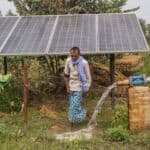Waiting Game: Where is All the Investment in Solar-Powered Productive Use Appliances?
Rapid growth in the solar-lighting market over the past decade has helped more than 360 million people living in off-grid communities in Africa, India and Southeast Asia gain access to basic electricity for the first time. In response to customer demand for additional services, many off-grid solar companies now offer household appliances like televisions and fans alongside solar lanterns and solar home systems. In some national markets, up to 85% of solar home systems include at least one solar-powered appliance in addition to lighting.
Attention is now turning to “productive-use” technologies, most often defined as solar-powered agricultural, commercial and industrial technologies that support income-generating activities. These can include solar water pumps, refrigerators, cold storage units and grain mills. Powered by standalone solar panels, solar home systems or mini-grids, these technologies are important parts of the energy access success story: They can improve the livelihoods of end-users by reducing manual labor, giving them access to new services to start businesses, reducing expenses, and providing them access to the full benefit of electrification. In East Africa, for example, 91% of new solar water pump customers reported a reduction in expenditure after using their pump, and 55% moved up the energy ladder.
This potential for transformational impact is drawing attention from the investment community. Despite this belief, however, the investment flow to companies developing and deploying productive use technology remains minimal.
Productive Use in Off-Grid Solar: Promise vs. Reality
Several prominent donor initiatives confirm the importance of productive use to the future of the off-grid sector. Last year, Lighting Global—the World Bank Group’s flagship energy access initiative that jump-started the off-grid solar industry—released a report on the market potential for productive use technologies. The report asserts that “productive use leveraging solar energy (PULSE) represents the next frontier for off-grid solar.” Similarly, the DFID-backed Powering Opportunities Partnership seeks to demonstrate the viability of business models focused on the productive use of solar, while the Rockefeller Foundation and CrossBoundary Energy-led Mini-Grid Innovation Lab recently launched an extensive study on the commercial benefits of productive use technologies for mini-grid operators. At Acumen, our Pioneer Energy Investment Initiative (PEII), launched in 2017, also has a specific investing strategy squarely focused on investing in productive-use technologies and business models.
To date, however, the increased donor focus on productive use – and the growing belief in the benefits of these technologies for end-users and market growth – do not match the reality on the ground. Where nascent markets for productive use technologies exist, sales are low and growth is flat. For example, just 3,142 solar water pumps were sold by GOGLA members during the first half of 2019, which pales in comparison to the estimated $450 million market opportunity cited in sub-Saharan Africa alone. For other productive use technologies, such as solar-powered grain mills or cold storage units, commercial markets remain almost non-existent. These challenges were illustrated in the recent Global LEAP Off-Grid Cold Chain Challenge, where many of the competing companies struggled to deploy systems for field testing, and most were unable to demonstrate commercial viability.
Commercial Investment in Productive Use Companies Remains Scarce
Compounding this lack of traction, there has been practically no commercial investment in productive use companies, even as investment in the broader off-grid solar sector grew by 20% between 2017 and 2018 to reach $352 million in total. While a limited set of early movers, particularly in the solar water pump market, have attracted initial financing, an overwhelming majority of the money invested in the off-grid solar market still goes to companies that sell lighting products or solar home systems. Without access to capital, companies already struggling to grow or demonstrate proof-of-concept face even more challenging headwinds.
Recognizing this disconnect, Acumen teamed up with the Efficiency for Access Coalition in late 2018 to launch the Efficiency for Access Coalition Investor Network. The network’s purpose is to bring together investors who are interested in investing in productive use companies, but who need additional insight into the market before doing so. By creating a forum for investors to ask questions, share lessons learned from prior investments and access technical insights from the Efficiency for Access Coalition, our assumption was that deals would follow.
But while the response among the investment community was strong, with 31 leading investment organizations agreeing to participate, it soon became clear that lack of deal flow was a major challenge for participants struggling to invest in productive use. Only three of the 31 investors had made an investment in a productive-use technology or business model when the network launched. Given the challenges facing productive use companies on the ground, it’s now apparent that the slow pace of investment may not reflect just information asymmetries and gaps in market intelligence. Rather, it may be an appropriate response to the nascency and risk of this sector for investors and customers.
Productive Use Markets Present Substantial Risk
In some ways, the current state of the productive use market looks similar to the early days of the off-grid lighting market, when commercial markets were non-existent, the target market had low awareness of the products, and companies were often not generating revenue or were still in the proof-of-concept stage. Considering the progress off-grid lighting has made since then, this comparison is promising for the future of productive use. But there are core differences between the two markets in terms of go-to-market strategies, product complexity and capital needs. These differences present unique risks for commercial investors, which include:
Technological Complexity: Productive-use technologies are physically large, and rely on complicated core components such as motors or compressors. Their performance is sensitive to user error (e.g., a refrigerator door left open). As a result, last-mile distribution logistics are difficult and expensive, while the complexity and size of the products increases the risk of failure in the field. This could lead to customers refusing to pay for a broken product, and to capital-intensive service and repair offerings.
Affordability and Access to Financing: The affordability gap for productive use products is significantly larger than for solar home systems. For example, a solar pump can cost over US $1,000, compared to a solar home system which sells at $120 – and even then, 65% of solar home system purchases require consumer finance for end-users to be able to afford them. The upfront cost of refrigerators without financing is 33 times more than the monthly disposable income for the poorest 50% of the off-grid population, as cited in Efficiency for Access’s State of the Global Off-Grid Appliance Market. What’s more, consumer financing is often unavailable for productive use technologies, making the products unattainable for most potential customers. Research on solar water pump market trends by the Efficiency for Access Coalition echoes this assessment, finding that just 13% of smallholder farmers in sub-Saharan Africa can afford a solar water pump.
High Cost of Distribution: Productive use sales agents spend a significant amount of time traveling to reach a small number of potential customers, and often make additional visits to train new customers – more so than sales agents for lighting companies. Guilhem Dupuy, investment director at Gaia Impact Fund, says “the transaction costs are a major challenge. For example, the density of potential customers for a cold storage company in a given geographic area is significantly lower than for a company selling solar lanterns, so it will take a lot more time to identify leads and close sales.”
Lack of Data to Support Due Diligence: Given the nascency of their businesses, productive use companies often do not have an extensive sales history, existing customer base and revenue trends in the investor diligence process. Customers express interest, but many are unable to afford the system. In addition, a wide range of proposed revenue sources and ownership structures by companies working with the same technology often compounds this challenge.
Higher-Stakes Default Risks: The business model that supports PAYGo financing for appliances cannot be copy and pasted from the solar lighting business model. The ability to shut off a system remotely is an important tool to manage payment default risk in PAYGo solar lighting, but the contribution of productive use technologies to a household’s income and livelihood makes the consequences of remote shut off more acute. Amanda Delcore of FACTOR(e) Ventures puts it this way: “With many productive use technologies, repayment may be seasonal or tied to the nature of the business the product supports. This raises an ethical question: Do you turn off a solar water pump if a farmer misses a payment? What are the implications of that for the farmer and their family? And then if you do turn off these products, it will likely be even harder for a customer to get back on track with their payments.”
The Productive Use Sector Needs High-Risk, Early-Stage Capital
While these challenges are daunting, they are not insurmountable. What the productive use sector needs is patient and high-risk investment capital that can support early movers in the space, address the challenges described above, and provide the additional hands-on support that pure commercial investors cannot at this early stage.
In Acumen’s PEII portfolio, we are already seeing two promising companies addressing the issues facing productive use companies. Acumen invested in Simusolar, a Tanzanian distributor of solar fishing lights and appliances, to see what we could learn from a company that had identified efficiencies in distributing third-party appliances to fishing communities. Acumen found that 70% of their customers moved up the energy ladder – meaning customers move from “worse” provisions of service to better provisions. The thesis that customers can move from a solar lantern and eventually to an off-grid appliance is critical for this sub-sector’s success. We also invested, alongside Total Energy Ventures, in Promethean Power Systems, a dairy milk chilling company that is tackling the $14 billion in lost revenue due to milk spoilage in India. Promethean’s milk chilling solution has helped increase farmers’ income by up to 20%. With their ability to reduce the cost of remote refrigeration by two-thirds and offer financing options to farmers for smaller units, Promethean is proving that technical and financial obstacles can be overcome.
That said, the investment community must be realistic about the readiness of companies in core productive use market segments. Appropriate support is required to addresses the unique risks these technologies present, paving the way for commercial investors to enter the sector. The following mechanisms and market ecosystem support activities can help achieve this:
Long-Term, Flexible Grant Funding: Companies require substantial amounts of working capital to support the R&D, field pilots, consumer research, strategic pivots and organizational capacity-building that will address many of the risks described above. Grant funding that is agnostic about commercial risk but instead tied to clear, measurable objectives can create a path to commercialization, allowing some productive use companies to attract private investment and deliver greater impact. The Efficiency for Access R&D Fund has funded 27 companies to date, addressing technical and design challenges across a range of productive use technologies – but more funding and grantors are needed.
Alternative Financing Mechanisms: Results-based financing (RBF) can direct donor funds to specific market barriers, while still incentivizing competition and capacity development among participating companies. Dupuy says investors view RBF funding as a selling point: “RBF schemes that help a company generate revenue over an extended period can be more useful in building investor confidence than a one-off grant, where the short-term benefit may actually be hiding longer-term risk regarding a company’s operations.” For example, the Global LEAP Results-Based Financing Program is facilitating the sale of more than 10,000 solar water pumps and 3,000 off-grid refrigerators across seven countries globally, which represent significant contributions to global market growth in both product categories.
Blended Finance: Deals that leverage donor and philanthropic funds as first-lost capital can de-risk potential investments in productive use companies for commercial investors. This may present the best near-term pathway to increase investment in productive use companies, but it will likely require a large proportion of grant funding in the capital stack, as well as skilled intermediaries.
Pipeline Development Support: A key takeaway from the Efficiency for Access Coalition Investor Network is that investors still struggle to surface potential investees and build pipeline in the productive use sector. In response to this, the Coalition is developing a catalogue of productive use companies to help investors understand who is active in a given product market, and assess those companies’ growth potential. Tools like this will enable investors to identify leads, as well as foster collaboration among investors on blended finance transactions for high-potential startups.
Consumer Intelligence: Productive-use companies lack the resources to conduct thorough research on consumer needs, ability to pay, financing requirements, drivers of purchasing decisions, or the impact on quality of life and livelihoods that their products deliver. Recognizing this, the Efficiency for Access Coalition supports a wide range of consumer research, from assessing the irrigation needs of smallholder farmers in Tanzania in collaboration with solar water pump distributors, to forthcoming research on agricultural machinery uptake among rice and corn farmers in India. 60 Decibels, an Acumen spin-out that focuses on raising the voices of customers, has articulated the uses and benefits of productive-use appliances for customers through its innovative lean data approach. Elevating more consumer insights will aid entrepreneurs in developing more effective go-to-market strategies.
Despite the challenges discussed above, productive use technologies hold the key to income generation for the world’s poorest off-grid communities. Many donors, investors and companies have hung their hat on this promise, and view it as the future of the off-grid market. Increased support and coordinated action from donors and early-stage patient investors can untangle some of the issues facing entrepreneurs and customers, and unlock commercial investment for promising models that will scale over the long term. Acumen and the Efficiency for Access Coalition are committed to facilitating this coordination and helping to make productive use work.
Leslie Labruto is Head of Global Energy at Acumen.
Jeff Stottlemyer is a senior manager at CLASP.
Photo courtesy of authors.
- Categories
- Energy



